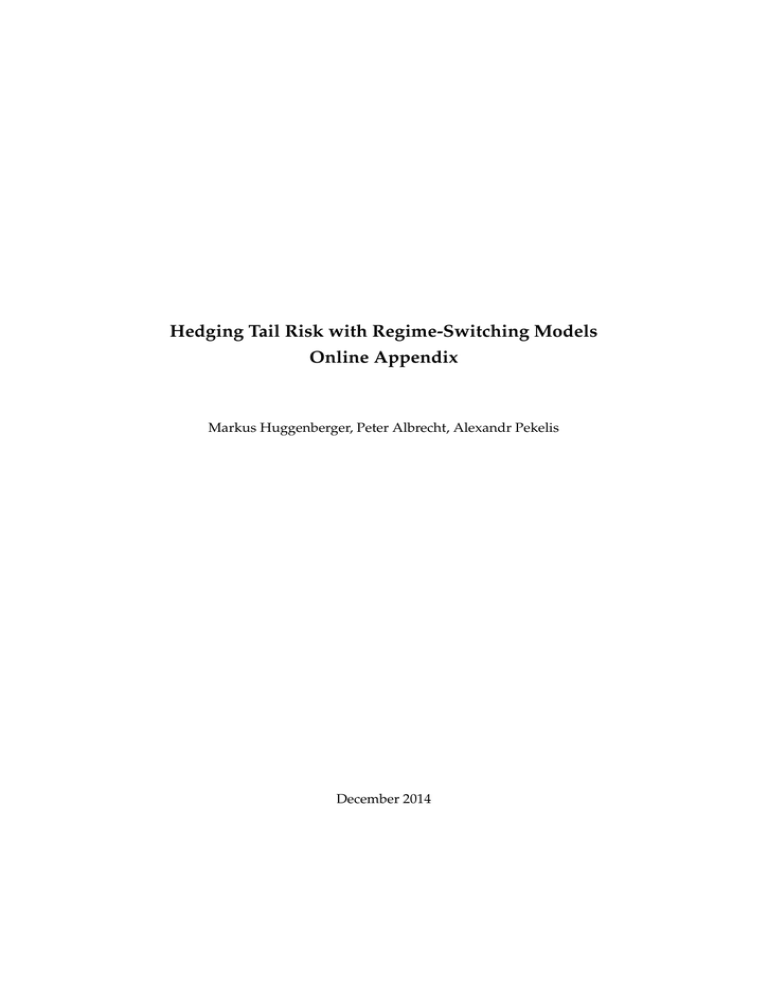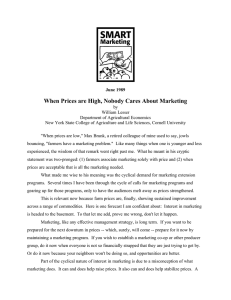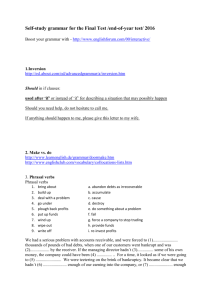Hedging Tail Risk with Regime-Switching Models Online Appendix
advertisement

Hedging Tail Risk with Regime-Switching Models Online Appendix Markus Huggenberger, Peter Albrecht, Alexandr Pekelis December 2014 A Tail-Risk Hedging for Simple Elliptical Distributions In this section, we look at the most basic setup of (M1), i.e., we analyze N = M = K = 1, which corresponds to an 1:1 hedging problem under the assumption of an ordinary elliptical distribution for the spot and the futures return.1 The resulting simplified version of (M1) can be written as 2 RS µS σS ρσS σF (A.1) ∼ E2 ( , , g). µF ρσS σF σF2 RF Under the additional restrictions (A.2) |z1−α | σF > |µF | or |λ1−α | σF > |µF |, we can solve (35) for the hedging weights, which are 2 s ! 2 1 − ρ σ S (A.3) , ρ − µF h∗VaR = 2 σF (g)σF2 − µ2F z1−α s ! σS 1 − ρ2 ∗ hCVaR = ρ − µF (A.4) . σF λ21−α (g)σF2 − µ2F (A.3) was proved by Hung et al. (2006) for the Gaussian case and generalized in Albrecht (2011) for elliptical distributions. These expressions allow for an instructive analytic comparison of minimum-variance and tail-risk-minimal hedging, which complements the discussion in Alexander and Baptista (2002, 2004) on VaRα - and CVaRα based portfolio selection problems. We see again the correspondence of variance and quantile-based hedging for µF = 0. In this case, the conditions for the existence of a tail risk minimizing strategy will always be satisfied. In general, theses conditions define a lower and upper limit for the expected futures returns. If the absolute value of the expected return of the futures contract is higher than the standard deviation scaled by |z1−α | or |λ1−α |, VaRα and CVaRα can be made arbitrarily small (negative) by increasing or decreasing h. Note that usually (A.2) will be satisfied because for small values of α, z1−α and λ1−α are greater than one and at typical investment or hedging horizons, the magnitude of σF dominates that of µF . The differences between variance and tail-risk-minimal hedging strategies follow simply from (A.3) and (A.4). In the case of VaRα , e.g., we obtain s 1 − ρ2 ∗ ∗ hVaR − hvar = −µF (A.5) , 2 z1−α σF2 − µ2F which leads to the following observations: (i) The variation increases in the absolute level of the mean of the futures return. If the mean of the hedging instrument is positive, 1 2 The assumption N = 1 is not crucial here. For any given multivariate RS and the corresponding weight vector w, we can deduce the distribution of w0 · RS and its correlation with RF . Note that the calculations involve solving a quadratic equation. Nevertheless, the hedge ratios are unique because only one solution of the quadratic equation solves the original problems in (35). 1 the hedging amount is reduced compared to the minimum-variance position. This can be attributed to a positive contribution of the futures position to the expected loss of the hedged portfolio. (ii) Both the variance of the futures return and an increasing confidence level lower the difference. (iii) For the same confidence level, the difference between minimum VaRα and minimum-variance hedging is greater than the difference between minimum CVaRα and minimum-variance hedging. (iv) Eventually, we see that the difference is only relevant if there is some basis risk because it decreases in the level of correlation.3 For a typical parameter constellation such as µF = 0.01, σF = 0.05, σS = 0.05, ρ = 0.90, α = 0.01, and assuming joint normality of the returns, we obtain h∗var = 0.90 and h∗VaR = 0.86, so that the minimum-variance approach can be seen as a good approximation to tail-risk-minimal hedging. We now provide closed form expressions for the attainable reductions on the level of VaRα and CVaRα derived from (34). We first calculate the VaRα for the optimal strategy using h∗VaRα from (A.3). Note that (A.6) (A.7) σS σS µL (h∗VaR ) = −µS + µF ρ − µ2F σF σF s 1 − ρ2 σL (h∗VaRα ) = σS · σF · z · z 2 σF2 − µ2F s 1 − ρ2 , − µ2F z 2 σF2 and thus (A.8) VaRα (h∗VaR ) = − µS + µF · ρ · q σS σS p + 1 − ρ2 z 2 σF2 − µ2F . σF σF Using the minimum-variance strategy, we obtain σS · µF , σF σL2 (h∗var ) = σS2 (1 − ρ2 ). µL (h∗var ) = −µS + ρ · (A.9) (A.10) The corresponding VaRα is (A.11) VaRα (h∗var ) = −µS + µF · ρ · p σS + z1−α (g) · σS · 1 − ρ2 . σF In the given example with µS = 0.01, we obtain VaRα (h∗VaR ) = 0.0495 and VaRα (h∗var ) = 0.0497, showing that also on the level of risk, the magnitude of reductions is very small. In general, it holds that s " # 2 p µ 2 (g) − F2 . (A.12) VaRα (h∗var ) − VaRα (h∗VaR ) = σS 1 − ρ2 z1−α (g) − z1−α σF 3 The first three effects (i) - (iii) are not surprising given (34), which shows that minimizing VaRα and CVaRα under elliptical distributions corresponds to a mean-standard deviation optimization, where the trade-off between these two objectives is described by the quantile risk constants z1−α and λ1−α . 2 The same reasoning can be used for CVaRα -minimal hedging, which yields s " # 2 p µ ∗ ∗ F 2 (A.13) CVaRα (hvar ) − CVaRα (hCVaR ) = σS 1 − ρ2 λ1−α (g) − λ1−α (g) − 2 . σF √ √ p Applying a − b ≤ |a − b| to (A.12), we obtain the following upper bound for the VaRα reduction σS p (A.14) VaRα (h∗var ) − VaRα (h∗VaR ) ≤ |µF | 1 − ρ2 , σF which confirms the importance of |µF | and ρ for the relevance of tail-risk-minimal hedging in the elliptical case. Since this reasoning is independent of the involved (risk) constants, the same bound holds for CVaRα hedging. B Further Empirical Results In this section, we provide further empirical results for our in-sample and out-ofsample analyses and especially for the robustness checks. In addition to estimation results, we show hedging results based on simple elliptical distributions and provide plots of smoothed probabilities for our RS models. Complementing Figure 2 in the main text, we provide exceedance correlations and lower tail dependence functions for the remaining examples. Table B.1: Parameter Estimates, Simple Elliptical Distributions (P1) (P2) (P3) par s.e. par s.e. par s.e. Multivariate normal distribution µS µF σS σF ρSF 0.80 0.50 2.98 4.42 86.52 (0.15) (0.23) (0.11) (0.16) (1.30) 0.75 0.50 3.04 4.42 66.73 (0.16) (0.23) (0.11) (0.16) (2.86) 0.81 0.50 3.26 4.42 81.40 (0.17) (0.23) (0.12) (0.16) (1.74) Multivariate standardized t-distribution ν µS µF σS σF ρSF 4.48 1.08 0.90 2.94 4.44 85.41 (0.78) (0.13) (0.20) (0.18) (0.28) (1.61) 5.26 0.98 0.87 2.84 4.35 60.77 (0.96) (0.13) (0.20) (0.15) (0.24) (3.68) 4.08 1.14 0.88 3.07 4.53 79.74 (0.64) (0.13) (0.19) (0.21) (0.31) (2.15) Note: In-sample parameter estimates for bivariate normal and standardized t-distributions. 3 (P1) 1 0.8 0.6 0.4 0.2 0 85 87 90 92 95 97 00 02 05 07 10 12 00 02 05 07 10 12 00 02 05 07 10 12 (P2) 1 0.8 0.6 0.4 0.2 0 85 87 90 92 95 97 (P3) 1 0.8 0.6 0.4 0.2 0 85 87 90 92 95 97 k=1 k=2 k=3 Figure B.1: Smoothed Probabilities for the Three-State RS Models presented in Table 2 Exceedance Correlations (P1) (P2) 0.8 0.8 0.6 0.6 emp mv-n mv-t RSN3 0.4 0.2 0.2 0.4 0.4 0.6 0.8 0.2 0.2 LTD Functions Quantile-Based Threshold 1 0.8 0.8 0.6 0.6 emp mv-n mv-t RSN3 0.2 0.02 0.04 0.06 0.08 0.6 0.8 Quantile-Based Threshold 1 0.4 0.4 0.4 0.2 0.1 α 0.02 0.04 0.06 0.08 0.1 α Figure B.2: Exceedance Correlations and Lower Tail Dependence Functions for the bivariate return distributions of (P1) - (P3) and the S&P futures 4 Table B.2: Parameter Estimates, EM Algorithm Panel A: RS K = 2 (P1) (P2) (P3) par s.e. par s.e. par s.e. State 1 µS,1 µF,1 σS,1 σF,1 ρSF,1 -0.57 -1.61 4.89 6.96 87.29 (0.83) (1.15) (0.58) (0.67) (2.64) -0.72 -2.25 5.13 6.89 73.43 (1.44) (2.05) (1.32) (1.03) (4.77) -2.60 -4.18 6.59 7.42 83.10 (1.54) (1.71) (1.63) (1.19) (4.25) State 2 µS,2 µF,2 σS,2 σF,2 ρSF,2 1.18 1.08 2.03 3.17 83.52 (0.14) (0.20) (0.12) (0.17) (2.18) 1.12 1.19 2.08 3.19 52.37 (0.13) (0.21) (0.18) (0.31) (5.38) 1.25 1.1 2.17 3.43 76.33 (0.17) (0.26) (0.16) (0.25) (2.60) 83.3 4.6 (7.4) (1.7) 81.2 4.7 (12.6) (1.7) 63.3 4.7 (11.6) (2.3) 0.00 100.00 - 0.00 100.00 - 0.00 100.00 - Transition matrix q11 q21 Starting probabilities π1 π1 Panel A: RS K = 3 (P1) (P2) (P3) par s.e. par s.e. par s.e. State 1 µS,1 µF,1 σS,1 σF,1 ρSF,1 -3.70 -6.17 4.85 6.29 82.69 (6.66) (10.66) (1.36) (4.42) (24.59) -4.89 -3.39 7.49 7.14 99.14 (3.37) (3.24) (2.03) (2.03) (0.48) -4.00 -6.12 7.85 8.11 82.25 (2.55) (2.61) (2.02) (1.55) (5.75) State 2 µS,2 µF,2 σS,2 σF,2 ρSF,2 1.46 1.36 2.48 4.01 81.13 (0.34) (0.44) (0.49) (0.50) (3.28) 0.76 -0.32 3.28 5.92 66.96 (0.41) (0.96) (0.38) (0.74) (6.46) 1.14 1.01 2.08 3.73 74.00 (0.17) (0.30) (0.20) (0.30) (4.41) State 3 µS,3 µF,3 σS,3 σF,3 ρSF,3 0.97 0.93 1.79 2.52 88.32 (0.21) (0.30) (0.15) (0.24) (2.24) 1.07 1.13 1.96 2.92 51.81 (0.16) (0.24) (0.13) (0.20) (6.29) 1.05 0.69 3.13 3.57 92.09 (0.36) (0.48) (0.31) (0.38) (2.19) 62.1 37.9 4.7 92.8 2.8 0.5 (34.7) (72.0) (4.9) (3.1) (2.6) (1.0) 41.3 35.3 4.8 88.4 1.1 3.6 (19.4) (37.5) (5.1) (8.3) (1.2) (2.3) 61.3 27.6 2.9 97.1 1.4 1.1 (14.0) (24.1) (1.7) (13.7) (2.3) (4.9) 0.00 100.00 0.00 - 0.00 0.00 100.00 - 0.00 100.00 0.00 - Transition matrix q11 q12 q21 q22 q31 q32 Starting probabilities π1 π2 π3 Note: In-sample parameter estimates for the bivariate RS models with two and three normal components obtained with the unconstrained EM algorithm. 5 Table B.3: Hedging Results, Simple Elliptical Distributions Panel A: mv-n (P1) uh Hedging weights [%] h1 Risk measures [%] el \α CVaR 7.14 ∆% e \α CVaR 12.38 ∆% pot \α 12.58 CVaR ∆% Moments (model/empirical) mean RH [%] 0.80 0.80 std RH [%] 2.98 2.99 skewness RH -1.35 kurtosis RH 3.00 8.38 Tail characteristics q̂0.9 2.45 ξ̂ 0.05 β̂ 2.78 Panel B: mvtstd (P2) var CVaR emp 58.43 56.98 72.46 3.47 3.47 0.11 4.75 -3.47 3.87 -11.50 4.11 10.40 4.84 4.91 -1.43 0.51 0.51 1.50 1.50 var CVaR emp 45.96 43.77 66.82 7.36 5.52 13.51 8.26 5.51 0.10 8.51 -3.04 6.10 -10.60 7.02 14.96 4.11 15.06 20.20 8.38 8.94 -6.63 0.52 0.52 1.50 1.50 0.44 0.44 1.62 1.62 0.75 0.75 3.04 3.05 0.52 0.52 2.27 2.27 -0.23 3.00 5.55 -0.31 3.00 5.72 0.36 3.00 5.14 -1.76 3.00 13.39 1.37 0.19 0.73 1.38 0.20 0.73 1.59 -0.10 0.92 2.61 0.57 1.34 4.59 (P1) uh Hedging weights [%] h1 Risk measures [%] el \α CVaR 9.37 ∆% e \α 12.38 CVaR ∆% pot \α CVaR 12.58 ∆% Moments (model/empirical) mean RH [%] 1.08 0.80 std RH [%] 2.94 2.99 skewness RH -1.35 kurtosis RH 15.37 8.38 Tail characteristics q̂0.9 2.45 ξ̂ 0.05 β̂ 2.78 (P3) uh var CVaR emp 60.05 58.22 91.54 7.87 4.54 15.13 7.55 4.53 0.10 7.73 -2.39 5.91 -30.27 6.06 19.81 7.10 15.33 16.02 7.28 7.26 0.25 6.10 16.21 0.53 0.53 2.27 2.27 0.41 0.41 2.45 2.45 0.81 0.81 3.26 3.26 0.51 0.51 1.89 1.89 0.52 0.52 1.89 1.90 0.35 0.35 2.35 2.35 -0.88 3.00 7.51 -0.97 3.00 8.11 -0.03 3.00 3.99 -1.72 3.00 13.31 -0.79 3.00 10.29 -0.88 3.00 10.99 0.21 3.00 4.53 2.12 0.16 1.39 2.15 0.26 1.21 2.53 -0.03 1.47 2.65 0.26 2.40 1.78 0.33 0.84 1.70 0.29 0.94 2.41 -0.52 2.41 var CVaR emp 60.05 51.86 91.54 6.12 2.17 8.36 -10.67 8.89 -42.02 6.06 19.81 (P2) var CVaR emp 58.43 54.51 72.46 4.88 4.85 0.72 5.03 -9.46 5.56 -13.86 4.11 10.40 4.84 4.97 -2.62 0.56 0.51 1.53 1.50 uh (P3) var CVaR emp 45.96 36.65 66.82 8.68 7.15 6.26 8.26 8.26 -15.54 7.02 14.96 10.12 13.51 7.02 1.72 9.32 -12.90 15.13 7.55 4.11 15.06 20.20 8.38 9.89 -17.97 7.10 15.33 16.02 7.28 7.87 -8.11 6.10 16.21 0.59 0.53 1.53 1.51 0.43 0.44 1.68 1.62 0.98 0.75 2.84 3.05 0.58 0.52 2.27 2.27 0.67 0.57 2.26 2.31 0.40 0.41 2.55 2.45 1.14 0.81 3.07 3.26 0.61 0.51 1.87 1.89 0.68 0.55 1.86 1.93 0.33 0.35 2.51 2.35 -0.23 15.37 5.55 -0.45 15.37 6.06 0.36 15.37 5.14 -1.76 7.76 13.39 -0.88 7.76 7.51 -1.25 7.76 10.06 -0.03 7.76 3.99 -1.72 74.4 13.31 -0.79 74.4 10.29 -1.17 74.4 13.31 0.21 74.4 4.53 1.37 0.19 0.73 1.30 0.12 0.89 1.59 -0.10 0.92 2.61 0.57 1.34 2.12 0.16 1.39 2.00 0.30 1.28 2.53 -0.03 1.47 2.65 0.26 2.40 1.78 0.33 0.84 1.61 0.32 0.97 2.41 -0.52 2.41 4.59 uh uh Note: Hedging weights and risk of minimum-variance and CVaRα hedging strategies; in-sample results for α = 0.01. uh: unhedged spot portfolios, var: minimum-variance hedging strategy, CVaR: elliptical CVaRα hedging strategy, emp: CVaRα hedging strategy based on Rockafellar and Uryasev (2002). h1 is the hedging weight of the S&P futures. el e \ α refers to parametric risk estimates based on elliptical distributions. CVaR \ α refers to empirical risk estimates CVaR pot \ α are POT-based risk estimates. ∆% is the relative tail risk reduction as compared to the minimum-variance and CVaR hedging strategy. 6 Table B.4: Parameter Estimates, Monte-Carlo Simulations skewed-t margins S1 F1 Copula parameters mean std νst λst ν ρ 0.81 0.50 3.26 4.42 3.46 5.69 -0.22 -0.22 6.08 80.68 Note: This table contains parameter estimates of the copula model used in our Monte-Carlo experiment. The parameters of the skewed-t distribution are obtained from MLE. The copula parameters are obtained after transforming the data with their marginal empirical distribution functions. Table B.5: Parameter Estimates, Composite Hedging par s.e. State 1 µS,1 µF1 ,1 µF2 ,1 σS,1 σF1 ,1 σF2 ,1 ρ1 [S, F1 ] ρ1 [S, F2 ] ρ1 [F1 , F2 ] -5.45 -3.74 -22.42 7.28 7.01 12.41 99.07 3.13 -7.47 (6.36) (5.79) (6.39) (2.31) (2.08) (2.20) (0.54) (22.82) (22.67) State 3 µS,3 µF 1,3 µF 2,3 σS,3 σF 1,3 σF 2,3 ρ3 [S, F1 ] ρ3 [S, F2 ] ρ3 [F1 , F2 ] 0.99 0.87 1.02 2.21 3.25 7.24 55.87 62.40 -4.83 (0.48) (0.59) (0.67) (0.25) (0.35) (1.37) (5.00) (6.43) (11.35) State 2 µS,2 µF 1,2 µF 2,2 σS,2 σF 1,2 σF 2,2 ρ2 [S, F1 ] ρ2 [S, F2 ] ρ2 [F1 , F2 ] Transition matrix q11 q12 q21 q22 q31 q32 Stationary distribution π1 π2 π3 par s.e. 0.90 -0.11 2.89 3.34 6.50 13.57 69.97 47.87 3.12 (2.22) (3.02) (2.62) (1.41) (1.74) (2.19) (15.30) (36.94) (70.73) 50.2 36.6 0.0 83.3 2.2 3.0 (15.5) (81.6) (48.4) (42.3) (6.0) (4.7) 3.42 21.13 75.45 Note: In-sample parameter estimates for a trivariate RS model with three normal components fitted to the joint distribution of (P2), S&P futures and oil futures returns. Robust standard errors are reported. 7 Table B.6: Parameter Estimates, RS t (P1) (P2) (P3) par s.e. par s.e. par s.e. ν 244.7 (26.5) 22.1 (16.1) 6.3 (1.4) State 1 µS,1 µF,1 σS,1 σF,1 ρSF,1 -3.76 -6.27 4.84 6.24 82.53 (5.22) (8.35) (1.18) (3.55) (20.16) -10.14 -8.72 5.53 4.52 99.29 (2.34) (1.96) (2.57) (2.05) (0.82) 0.53 0.26 5.33 5.72 93.74 (0.66) (0.74) (0.75) (0.63) (1.46) State 2 µS,2 µF,2 σS,2 σF,2 ρSF,2 1.46 1.37 2.49 4.02 81.03 (0.33) (0.44) (0.41) (0.42) (3.31) 0.97 0.62 2.96 5.19 65.27 (0.24) (0.38) (0.29) (0.46) (4.98) 1.43 1.23 2.00 2.47 69.17 (0.18) (0.22) (0.16) (0.18) (5.35) State 3 µS,3 µF,3 σS,3 σF,3 ρSF,3 0.98 0.93 1.80 2.54 88.36 (0.20) (0.30) (0.15) (0.26) (2.22) 1.03 0.92 1.90 2.64 47.67 (0.17) (0.23) (0.13) (0.36) (8.32) 0.90 0.60 2.67 4.94 79.32 (0.18) (0.33) (0.20) (0.32) (3.00) Transition matrix q11 q12 q21 q22 q31 q32 61.4 38.5 4.6 92.8 2.8 0.8 (30.9) (59.7) (4.2) (3.0) (2.6) (1.3) 30.2 57.3 2.7 94.7 0.0 3.0 (18.8) (20.1) (1.9) (2.6) (3.6) (1.4) 97.4 2.1 0.9 97.8 0.0 1.0 (9.3) (2.1) (0.7) (1.4) (0.7) (0.5) Stationary distribution π1 π2 π3 9.2 53.2 37.6 - 1.9 48.0 50.1 - 12.7 35.0 52.3 - Note: In-sample parameter estimates for bivariate RS models with three t-distributed components fitted to the bivariate distribution of (P1) - (P3) and the S&P futures returns. Robust standard errors are reported. 8 Table B.7: Parameter Estimates, Parameter Estimates (P3) Discrete returns RS K = 3 (P3) 1st sample half par s.e. par State 1 µS,1 µF,1 σS,1 σF,1 ρSF,2 -3.62 -5.58 7.77 7.84 83.16 (2.11) (2.43) (1.84) (1.50) (6.06) -6.28 -11.59 4.67 6.62 69.49 State 2 µS,2 µF,2 σS,2 σF,2 ρSF,2 1.11 0.75 3.15 3.58 92.07 (0.38) (0.55) (0.30) (0.36) (2.18) 1.22 1.21 1.99 3.52 72.85 State 3 µS,3 µF,3 σS,3 σF,3 ρSF,3 1.14 1.06 2.12 3.79 74.19 (0.17) (0.29) (0.20) (0.26) (4.95) 61.4 10.9 1.5 97.2 2.6 0.1 (14.5) (28.7) (2.1) (10.1) (1.8) (17.3) 38.3 2.1 5.64 22.90 71.46 - 3.2 96.8 Transition matrix q11 q12 q21 q22 q31 q32 Stationary distribution π1 π2 π3 s.e. (P3) S&P spot (P3) Spot indices par s.e. par s.e. (1.19) (2.57) (0.78) (1.90) (21.12) -4.02 -5.97 7.86 8.17 82.63 (2.39) (2.47) (1.82) (1.53) (5.01) -2.46 -2.69 8.90 7.34 92.57 (2.87) (2.49) (3.16) (1.89) (2.98) (0.15) (0.26) (0.11) (0.20) (3.38) 1.14 1.25 2.08 3.73 74.95 (0.15) (0.28) (0.16) (0.29) (3.95) 1.42 1.09 2.37 2.90 79.74 (0.26) (0.30) (0.44) (0.39) (5.56) 1.05 0.72 3.11 3.52 91.99 (0.35) (0.45) (0.35) (0.41) (3.08) 0.42 0.03 2.96 5.27 81.07 (0.37) (0.65) (0.34) (0.40) (4.39) (20.7) (1.2) 61.2 28.8 2.8 97.2 1.5 1.1 (14.6) (19.7) (1.6) (10.5) (1.9) (5.7) 74.8 24.7 3.1 96.4 0.0 1.8 (34.2) (15.2) (3.8) (4.0) (7.0) (1.7) - 5.9 70.2 23.9 - 8.46 68.52 23.02 - Note: The estimation results for discrete returns are obtained using the full sample. (P3) 1st sample half refers to the subsample from April 1983 to November 1998 using 188 return observations. (P3) S&P spot uses the spot index as a hedging instrument. (P3) Spot indices refers to estimation results when the spot indices are replaced by: MSCI All Country World Total Return Index, BofA Merrill Lynch High Yield Master II Total Return Index and FTSE/EPRA NAREIT North America Total Return Index using 291 observations from April 1990 to June 2014. 9 References Albrecht, P. (2011). Zur Theorie des Value at Risk-minimalen Hedges. zfbf - Schmalenbachs Zeitschrift für betriebswirtschaftliche Forschung, 63:2–18. Alexander, G. J. and Baptista, A. M. (2002). Economic implications of using a mean-VaR model for portfolio selection: A comparison with mean-variance analysis. Journal of Economic Dynamics and Control, 26(7–8):1159–1193. Alexander, G. J. and Baptista, A. M. (2004). A comparison of VaR and CVaR constraints on portfolio selection with the mean-variance model. Management Science, 50(9):1261–1273. Hung, J.-C., Chiu, C.-L., and Lee, M.-C. (2006). Hedging with zero-value at risk hedge ratio. Applied Financial Economics, 16(3):259–269. Rockafellar, R. T. and Uryasev, S. (2002). Conditional value-at-risk for general loss distributions. Journal of Banking & Finance, 26(7):1443–1471. 10




